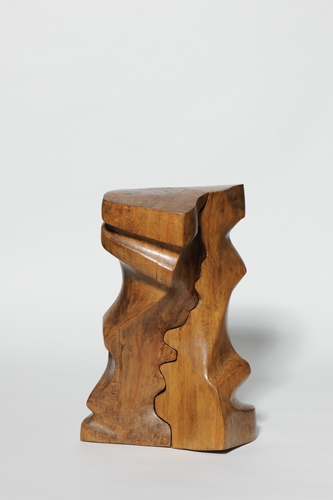It is tempting to look at Saloua Raouda Choucair’s work as a demonstration of how the modernist ‘language’ of abstraction crossed ethnic and national boundaries in its bid to become a universal mode of communication, one stripped of the proclivities of local linguistic and graphic inheritances in order to tap pure affect and sensation. Choucair is Lebanese. Born in 1916, she travelled to France during the late 1940s, where she encountered Le Corbusier’s architecture and studied with Fernand Léger – what better duo to unlock the secrets of form? When she returned to Beirut, she brought those secrets with her and whispered them within the precincts of her homeland’s Islamic art and architecture, creating a body of work that is at once grounded by those regional artistic legacies and set in flight by the formal experiments and liberations licensed by Modernism. We now know that, though modern art began in the crucible of colonialism, by the 1930s and 40s it had gained refugee status, its practitioners and proponents escaping from Europe to North and South America, the Middle East and as far as Asia. In Choucair it found asylum.
Lifting off the ground as it did, though, modern art had always risked losing touch with its audience. Even when aiming at the demotic it was elitist (read bourgeois). Riven internally, modern art struggled formally, adopting new techniques and materials and practices in order to find acceptance. Choucair never shied away from such ventures – see her small plinthmounted clay and metal, clay and plastic Water Projects from the 1970s and 80s – but her work is at its best in wood and stone, ceramic and tapestry, and at modest scale, even though she always wanted to realise big projects, like Corb. Her Project for Public Housing (1973), a small double-stack of terracotta A-frames, surely works better as a tabletop sculptural folly than as an architectural model. Though her Infinite Module and Infinite Structure (both 1974–2014) gesture towards skyscraping, their stacked stone units appear more like fastidious cairns, heavily weighted and speaking to their maker’s hand and efforts.
Worth special recognition is Choucair’s facility with wood. Secret of a Cube (1960–62), a small, roughly 12 x 15 x 12 cm block of what looks like walnut, holds lovely biomorphic folds within its otherwise rational coordinates. Moving Dual (1983–5) splits the cube in half and then extrudes, twists and ripples it upwards, its two halves filling in for one another down the work’s wobbly cleave.
This quality of being separate-but-joined is present in many of Choucair’s pieces here – eg Bench (1969), Poem Box (1972–4), Dual (1975–7), Sliding Dual (1975–7) – but gives way to works that only gesture at separation without enacting it physically, as in her small terracotta The Rhyme Series (1994–6) and Quantum Leap (1985–2011). Brancusi looms large here. Not just the Brancusi of the Endless Column, to which Choucair’s Infinite Module and Infinite Structure as well as her Movement of the Angle (1983–5) pay dues, but the Brancusi of The Kiss (1916), which thematises separate-but-joined as a condition of desire, if not love. It would be too much to say that love is what many of Choucair’s works are after, unless we are to understand it as a love of form, and so of the abstract language of modern art, to which Choucair was joined.
This article first appeared in the March 2016 issue of ArtReview
